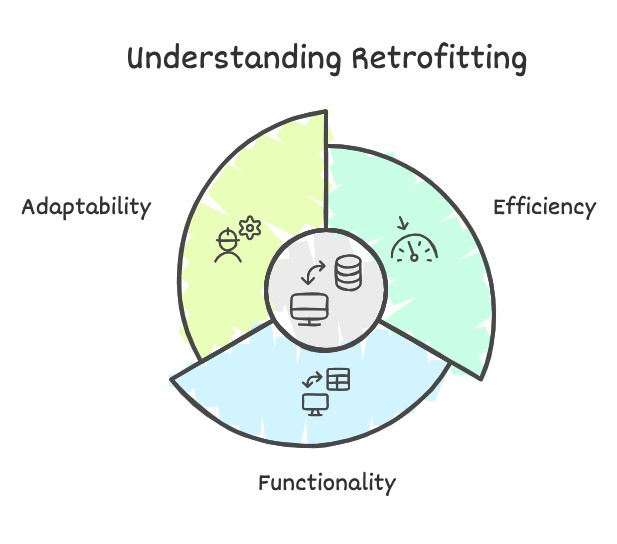Menu
The concept of retrofitting is gaining more and more attention in various sectors, from construction to manufacturing. But what exactly does retrofitting mean and why is it considered an economically attractive solution?
Retrofitting, or modernisation of existing equipment and structures, refers to the process of upgrading existing systems, technologies or infrastructures to improve their efficiency, functionality or adaptability to modern regulations. Rather than completely replacing an asset, retrofitting takes existing elements and adapts them to meet new needs or requirements.
For example, in industry, it involves upgrading machinery to improve energy efficiency or to comply with environmental regulations.

ECONOMIC BENEFITS
- Initial cost savings: Upgrading an existing infrastructure is often much cheaper than building or acquiring a new one. This
- significantly reduces the initial investment.
- Energy efficiency: Many retrofitting initiatives are designed to reduce energy consumption. This not only reduces
- emissions, but also generates substantial savings on energy bills.
- Longer service life: By retrofitting equipment and structures, their service life is extended, delaying the need for total replacement and amortising the investment over a longer period of time.
- investment over a longer period.
- Regulatory compliance: Many industries and buildings need to adapt to new environmental or safety regulations. Retrofitting
- allows these requirements to be met without the need for complete replacement of the facility.
- Asset appreciation: A retrofitted asset is not only more functional, but can also increase its market value.
If we focus on the industrial market, which is our market, it is clear that retrofitting is a very interesting solution because with a much lower investment than you would make with the purchase of new machinery, you get machines adapted to current needs with high quality and efficiency.
ENVIRONMENTAL BENEFITS
- Reduced energy consumption: By upgrading components such as motors, control systems and variable frequency drives, retrofitting can improve the energy efficiency of machines. This not only reduces costs, but also lowers the industry's carbon footprint by reducing the consumption of electricity from non-renewable sources.
- Lower emissions of polluting gases: Older machines are often less efficient and generate higher pollutant emissions. Retrofitting improves combustion and emission control systems, helping to meet the latest environmental regulations. In addition, many retrofits incorporate technologies that favour the use of renewable energy or monitoring systems that optimise resource use, helping industries to become more sustainable.
- Extending the life of equipment: By refurbishing machinery instead of scrapping it, the need to produce new machines is avoided. This supports a more circular economy, where existing resources are utilised and waste is minimised.
- Compliance with stricter environmental regulations: Retrofitting processes allow companies to adapt their equipment to the latest environmental regulations without having to invest in completely new machinery. This not only reduces costs, but also helps companies avoid penalties for non-compliance with emissions and energy efficiency regulations.

And although retrofitting can be applied to any type of machinery, whether milling machines, machining centres, EDM machines, lathes, presses, etc., at MTLA we specialise in centreless grinding machines.
In addition, another advantage of retrofitting the machines, apart from the economic and environmental ones we have already seen, is the ability to configure the machine to the customer's specific needs and budget, since, depending on what these are, it will be possible to:
Automate one or several axes to CNC
Incorporate part measuring systems
Electrical cabinet with specific components
Insert a grinding wheel balancing and cooling system
Include (or not) parts loader-unloader
Incorporation of fairing
And a long etc.
In other words, in addition to being able to modernise a machine at a lower cost than buying a new one, retrofitting allows us to automate the machines, which is essential in a world where efficiency and precision are the order of the day. New devices are transforming the way we work and improving productivity significantly.
In other words, retrofitting represents a smart and sustainable solution to improve existing infrastructures and systems without incurring the high costs of complete replacement. With economic, environmental and operational benefits, it is emerging as a key strategy for companies and institutions looking to optimise resources and adapt to the challenges of the future.
Do you now consider how retrofitting can benefit your organisation or project?
